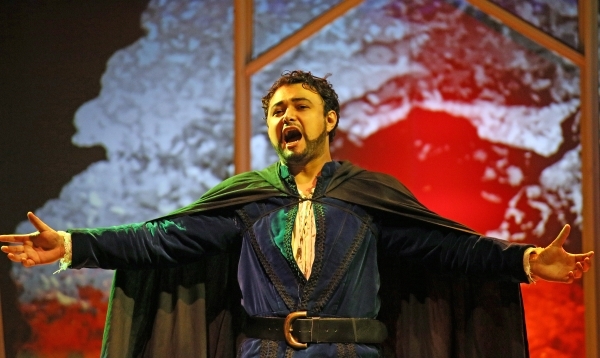
Academy of Vocal Arts, Philadelphia, April-May 2015
Faust remains popular because it reminds us that people will do virtually anything to recapture their youth.
It became a classic for another reason, however — its dramatic presentation of the battle between God and Satan for the eternal soul of a man. Goethe’s tragic play written between 1772 and 1831 shows the aging Faust desirous for infinite knowledge; while Gounod’s 1859 opera changes the main temptation to sexual lust. Either way, Faust makes a deal with the devil: He’ll get his wish on Earth, and in exchange Faust will serve the devil in Hell.
The AVA cast was in their twenties, and I doubt if many (or any) of them fear being dragged to hell if they have premarital sex. Few of today’s youth believe literally in the devil, nor do they believe that God will physically lift them to heaven as happens to the heroine at the end of the opera. Their ability to convey this supernatural faith, in this modern age, was a tribute to the direction of Tito Capobianco and training by maestro Christofer Macatsoris and the coaches at AVA.
The vocal maturity of the singers is not in question; we know that a good number of AVA grads go quickly to the stages of the Met and other major opera houses. What’s surprisingly impressive is how these young people persuaded us that they feared Satan and trusted in a celestial being to save them. In this production they made the sign of a cross to disable the devil, and sprinkled holy water to make dead flowers bloom. They did this with sincerity and conviction reflected in their faces. A new generation was coming to grips with the moral attitudes and the religious faith of an earlier time.
The Met’s 2011 production by Des McAnuff dismissed all the reliogisity and turned Faust into a deal made with the devil by atomic scientists so they could explode a bomb. Capobianco, on the other hand, has been an internationally acclaimed director for six decades and believes in staying faithful to the author’s and composer’s intentions. His work shows that an opera can be revealed creatively, with provocative action, without the gimmick of changing the intent or the period. His rehearsals stressed attitude and mind- set as well as stage movements.
The scenery which he devised with Albert Filoni used projections of art from the medieval period, including Dürer, Bruegel and Caravaggio. Flanking the stage were large panels reproducing Michelangelo’s painting on the ceiling of the Sistine Chapel. To the left was a nude Eve, to the right a judgmental God. Later on, a panel revealed Michelangelo’s snake in the Garden of Eden.
The orchestra sounded superb under conductor Macatsoris. The singers were all of professional calibre and exciting promise. Because there were rotating casts, the only fair thing is to cite them equally. They are tenors Diego Silva, Mackenzie Whitney and Dominick Chenes as Faust, sopranos Melinda Whittington, Huanhuan Ma and Marina Costa-Jackson as Marguerite, basses André Courville, Anthony Schneider and Nathan Milholin as Mephistofeles, baritones Michael Adams, Jared Bybee and Hunter Enoch as Valentin.
It should be noted that this production eliminated ballet and some choral scenes, because all the performers were from the small roster of AVA resident artists. Certain choral passages with organ were pre-recorded in a nearby church by resident artists.
Read more reviews on The Cultural Critic